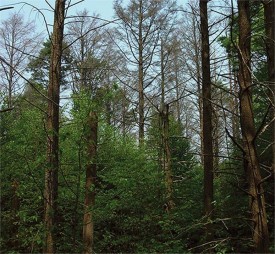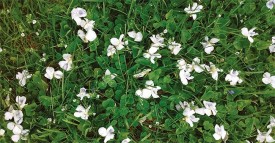The recent decline in the population of bees and other pollinators because of pesticides, climate change, diseases, and other causes has raised alarms among those concerned about crop…
Discoveries
Serving Up Seeds
Small mammals like squirrels, chipmunks, mice, and voles play a surprisingly significant role in determining the tree composition of most forests. That role is based largely on their choice of…
Go Easy on the Salt
Applying salt to snowy roadways is an effective way of melting snow and ice and making driving safer. But what happens when that salty snowmelt runs off into nearby lakes and ponds? It has…
Old Growth Quickly
Landowners seeking to make money selling carbon credits while also continuing to sell timber have a new forestry technique to consider. A University of Vermont forest ecologist has developed a…
Hydrophonics
Plants and trees are seldom considered to have acute senses – at least, not like those of many mammals. But scientists at the University of Western Australia discovered that plants have…
Birds of the Forest
In one of the longest-running studies of its kind in North America, the Vermont Center for Ecostudies has documented a 14.2-percent decrease in Vermont forest birds over the past 25 years.…
Hemlock Hydrology
Hemlock wooly adelgid, the invasive insect from Japan that is wiping out most of the hemlock forests in the eastern United States, is also having a significant effect on the availability of…
Living on the Edge
As human population grows, forests often become more and more fragmented as trees are cut down to make way for roads, housing developments, office parks, and shopping centers. Most research on…
Ups and Downs
Many scientists have predicted that as the climate warms, most bird species in the Northern Hemisphere will shift their ranges northward or up the slopes of mountains in order to remain in…
Backyard Bee Bonanza
Lawns cover 63,000 square miles of the United States, making turf the largest irrigated crop in the country. As much as some ecologists consider lawns to be biological deserts that Americans…
All Cleared Up
A team of engineers at the University of Maryland has created transparent wood windows that are waterproof and less breakable than glass. What’s more, the windows provide more even and…
Changes in Ranges
Researchers have long believed that the changing climate will force most species of birds to shift their ranges to follow their preferred climate niches. Rather than adapting to the new…
A Secret Sensor
Anyone who has paid even a little attention to plants and trees in late winter and early spring knows how responsive they are to temperature. In years when the winters are warm, many trees and…
Market Building for Norway Spruce
It has been more than 80 years since a tree species in the Northeast has been added to the list of those meeting construction industry standards, but that list has just grown by one. Lumber…
Removing Those Dam Things
Most of the 14,000-plus dams that dot New England’s rivers and streams – almost all built more than a century ago – once provided power to nearby mills. While these mills no…
Cause and - Wait for It - Effect
Twenty years ago, scientists experimented with adding calcium to forest soils and found that it boosted tree growth. Today, they’re seeing an unexpected spike in nitrogen loss in these…
Monarch Migration Mystery
The long, instinctive migration of monarch butterflies from the northern United States and Canada to their wintering grounds in central Mexico is considered one of the natural world’s…
Fewer Fires in the Forest
As the composition of tree species in forests in southern New England has evolved in recent decades, many of those forests have become more vulnerable to drought. The reason for the changing…
Long-Distance Delivery
In the world of trees, it is difficult for seeds and seedlings to take root far from their parent plants, yet that’s a key factor in seedling survival. “The closer you are to mom,…
Leaf Litter Stunner
A team of researchers has been studying the effects of adding extra leaf litter and other organic matter to the soil in Harvard Forest for more than 25 years. The original purpose was to test…















